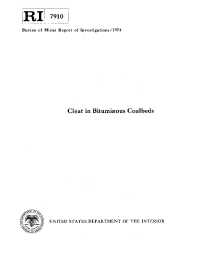Mining Publication: Cleat in Bituminous Coalbeds
Original creation date: January 1974
The natural vertical fracture system in bituminous coalbeds is called cleat. Cleat orientation commonly controls the direction of mining with major development paralleling the face cleat. Previous researchers have categorized the origin of cleat as endogenetic, relating the origin of cleat to compaction and coalification, and exogenetic, relating the origin of cleat to tectonic forces. In the coalbeds studied for this report it was found that tectonic forces were the controlling factor of cleat formation. Face cleats were formed as extension fractures during structural deformation, and butt cleats, as release fractures during erosion and uplift. The face cleat of the Pittsburgh coalbed rotates from N 80 deg W in northwestern West Virginia to N 57 deg W in southwestern Pennsylvania; the face cleat maintains a perpendicular orientation to the shifting axial trend of local structures. Cleat orientation in other bituminous coalbeds in Virginia, Utah, Oklahoma, and central Pennsylvania showed a similar relationship to local structure. Directional permeability of coal is directly related to cleat. Holes drilled perpendicular to the face cleat yield from 2.5 to 10 times the amount of gas released as compared with holes drilled perpendicular to the butt cleat.
Authors: CM McCulloch, M Deul, PW Jeran
Report of Investigations - January 1974
NIOSHTIC2 Number: 10000624
Pittsburgh, PA: U.S. Department of the Interior, Bureau of Mines, RI 7910, 1974 Jan; :1-25
See Also
- Investigation of Coal Properties and Airborne Respirable Dust Generation
- Methane Emission from U.S. Coal Mines in 1975, A Survey : A Supplement to Information Circulars 8558 and 8659
- Methane Emission from U.S. Coal Mines, A Survey
- Methane Gas Content of the Mary Lee Group of Coalbeds, Jefferson, Tuscaloosa, and Walker Counties, Ala.
- Problems Facing Coal Mining and Gas Production in the Hartshorne Coalbeds of the Western Arkoma Basin, OK
- Research and Development Contract for Coal Mine Communication System: Volume 1 - Summary and Results of System Study
- Research and Development Contract for Coal Mine Communication System: Volume 2 - Mine Visits
- Research and Development Contract for Coal Mine Communication System: Volume 3 - Theoretical Data Base
- Reservoir Modeling-Based Prediction and Optimization of Ventilation Requirements During Development Mining in Underground Coal Mines
- Use of Surface Joint and Photolinear Data for Predicting Subsurface Coal Cleat Orientation
- Content source: National Institute for Occupational Safety and Health, Mining Program


 ShareCompartir
ShareCompartir
